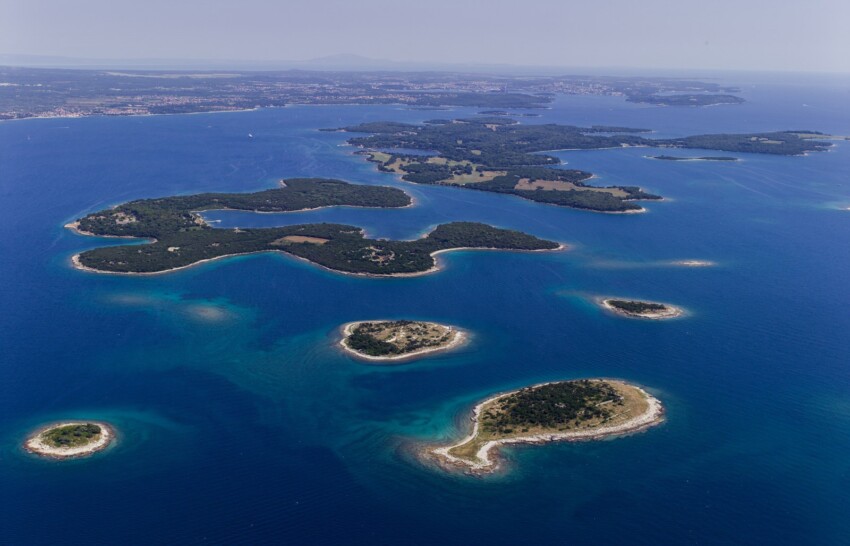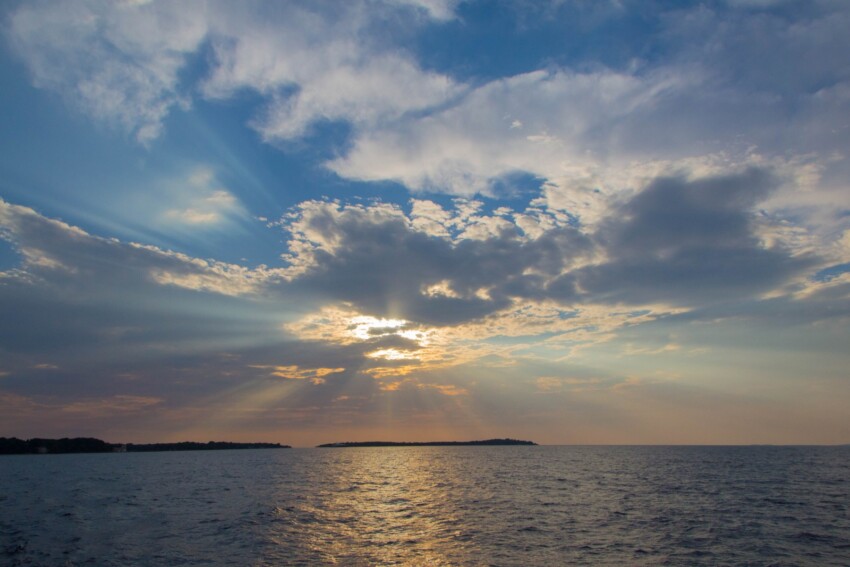

14 islands scattered along an arm of the sea of just a few square kilometres: not much? Not if we are talking about the Brijuni Islands, an archipelago north-west of Pula that can justifiably be considered one of Croatia ‘s most VIP destinations thanks to their illustrious past.
Inhabited since antiquity, they were purchased in 1893 by the wealthy Austrian industrialist Paul Kupelwieser with the perfectly successful intention of transforming this uncultivated spot into a luxury holiday resort for aristocrats and celebrities.
In 1930 the property passed to the Italian state, which then ceded it to Yugoslavia in 1945. Tito made them his summer residence, and it was during these years that the islands were frequented by actors and heads of state as guests of the Yugoslav president.
In 1983, the islands became a national park and the hotels once reserved for celebrities welcome tourists eager to treat themselves to a fairytale stay. Those on a tighter budget can comfortably visit the larger island on a day trip, taking a boat to Fažana and then following a guided tour or wandering around independently on foot, by bike or in electric golf cars.
The Brijuni Islands National Park is truly an attraction not to be missed: a place of peace and luxury at the same time, where in a single day you can experience the splendour of imperial courts and the serenity of nature. Unforgettable walks, visits to ancient ruins, rich people’s curiosities and relaxation on the beach await you.

Only one of the Brijuni Islands is open to visitors, and that is theMain Island. Other islands are only open to visitors on special occasions, e.g. the Lesser Island can be visited during the Ulysses Theatre, while others are only open for state visits, others are always closed.
No harm done: on the Big Island alone there are enough attractions to keep you busy for a whole day and wishing you could stay longer!
The Safari Park is perhaps the most bizarre area of the park: it is a nine-hectare fenced-in area along the northern coast of Main Brijuni where animal breeds of different origins live together.
In the past, the area was Tito’s private hunting ground and it was he who put together this unusual collection of living specimens of typical local fauna together with exotic animals from Africa, Asia and South America. On the tour, you can see ostriches, peacocks, llamas, zebras, zebu, Istran oxen and sheep and other animals in the wild. The star of the park, however, is the elephantess Lanka, donated in 1972 by the then Prime Minister of India, Indira Gandhi.
The Safari Park can only be visited on the tourist train and is the first stop on the guided tour of the Isola Maggiore.
It is certainly not the reason why tourists visit the Brijuni Islands, but once they get here, everyone wants to see it: we are talking about the dark green Cadillac Eldorado Cabriolet donated to Tito in 1953 by an organisation of Yugoslav emigrants in Canada.
Tito used it to tour the islands from 1953 to 1979, a total of around 18,000 miles. Often on his tours he was in the company of such illustrious personalities as Sophia Loren, Elizabeth Taylor, Indira Gandhi, Richard Burton and the first female astronaut Valentina Tereskova.
Perfectly preserved, this gleaming car today drives newlyweds and tourists willing to spare no expense to treat themselves to a dream.
The Koki parrot is exactly what its name suggests: a living specimen of a parrot, specifically a large white cockatoo with a yellow tuft. It belongs to a rare species, but has become a famous tourist attraction for another reason: Koki is the special present Marshal Tito gave his granddaughter Alessandra for her ninth birthday.
During his 50 years of life, Koki has already been photographed with numerous film stars and politicians; in recent years, however, he has been immortalised by an increasing number of tourists. His life expectancy is about 100 years: he still has plenty of time to grow his photo collection!
The Boat House is the Austro-Hungarian Secessionist-style building built in 1902 that you will notice as soon as you arrive at the harbour on Isola Maggiore. It is also called the Doctor’s House because it was inhabited by an island doctor.
Today it is the seat of a national park education centre and houses a permanent exhibition that will introduce you to the rich landscape and cultural heritage of the islands.
The Brijuni Islands have been inhabited since ancient times and preserve clear traces of their thousand-year history.
During a tour of the islands, you can admire the most significant remains from different eras. Among the most interesting are a Roman villa from the 1st century located in the enchanting Verige Bay; the Basilica of St Mary, the oldest Christian building on the island; the 15th-century Church of St. German in which an original mosaic from the Roman villa in Verige Bay is preserved.
Inside the Byzantine castrum, an area of more than a hectare, there are finds from the Roman Empire, the Eastern Goths, Byzantium, the Carolingian period and Venetian rule.
It is not only ancient peoples who inhabited the Brijuni Islands in times long past: well before them – a hundred million years ago – dinosaurs lived here.
When you enter the harbour of Veliki Brijun, you can see the imprint of a tridactyl in a limestone block. Other footprints can be seen scattered around the island, others have been found on the islands of Vanga, Gallia and Vrsar (not accessible to visitors).
The most relaxing part of a visit to Veliki Brijun is when you enter the Mediterranean Garden, a green area covering an area of 17,000 square metres that was once used as a forest nursery. More than 150 plant species grow within this area, including both indigenous and exotic plants.
Acqua Viva is a monument dedicated to an exceptional technical achievement on the Brijuni Islands: the extraction of spring water.
It is a glass pyramid of little interest in itself, but of high symbolic value; a plaque next to the monument recounts the technical details of spring water extraction.
A bronze sculpture of a woman with a bellows has been erected next to the monument. The entire complex is supposed to serve as a fountain, but is not currently in operation.
At this point you may be wondering: but can you bathe in this idyllic place? The answer is yes: you can sunbathe on Isola Maggiore and bathe in the crystal-clear waters that wash it at Saluga beach, a sandy beach shaded by centuries-old pine trees.
Deck chairs and umbrellas can be hired and there is a refreshment stand.
In the following map you can see the location of the main places of interest mentioned in this article.

The Brijuni Islands are the ideal location not only for a day of contemplative idleness, but also for those who enjoy outdoor activities.
The Main Island is criss-crossed by easy but fascinating themed trails. The most beautiful is the Panoramic Path, which takes you to the belvederes built by Paul Kupelwieser in the early 20th century. These are elegant wrought-iron turrets from which the illustrious visitors of the past admired the beauty of the island’s landscape: a privilege we can all enjoy today.
The most original path, on the other hand, is the Path of Good Feelings, which connects eight spots with beautiful views (three on Fažana and five on Veliki Brijun) where chairs, benches and artistic swings have been placed. These are oases of relaxation designed to banish the bad thoughts and stress of everyday life while contemplating the beauty and serenity of nature. The path can be travelled on foot, but it is recommended to do so by bicycle.
There is also a 13-km cycle path on asphalted terrain, which is accessible to all, and an easy underwater educational trail suitable for those able to swim with fins and snorkel. Experienced divers can choose from three different diving spots.
Other sports that can be practised on the main island are golf and tennis.
If you think four hours is too short a time to enjoy the beauty of these pristine and exclusive islands, you can treat yourself to a night in one of the Brijuni hotels.
Sleeping on the Brijuni Islands is possible, but at a high price: there are only four hotels (plus two villas) and they are all of medium-high category, converted from skilfully renovated historical buildings.
They are fabulous accommodations that will make you relive the atmosphere of luxury and prestige of the 20th century, perfect for a special occasion or for those who want something exclusive. They have spacious rooms overlooking the sea or lush gardens, elegant furnishings and professional but discreet staff, accustomed to a wealthy clientele that demands absolute privacy and an impeccable level of service.
As an alternative to these costly accommodations, which are certainly not for everyone, you can look for a hotel or flat in Fazana or Pula, two locations with a wide choice of tourist accommodation in all price ranges.
Many guidebooks mention a campsite on the Brijuni Islands: be careful because it is not on the islands, but on Fažana territory.
In order to visit the Brijuni Islands, it is necessary to purchase an entrance ticket to the national park. Tickets can be purchased at the marina from which boats depart in Fažana or online at the official park website.
The price of an entrance ticket to the Brijuni Islands includes
The national park is open to visitors all year round; boat departure times vary according to season.
In the summer months it is strongly recommended to purchase the ticket online before departure: when purchasing, you must choose the day and time of the visit and the language of the guided tour.

Here is some practical information for visiting the Brijuni Islands that will help you organise your day (or days!) in this wonderful place:
The easiest and cheapest way to reach the Bri juni Islands is to join an organised excursion departing from Fazana, a town about ten kilometres from Pula. There are also tours departing from Pula, but they are more expensive, so it is advisable to reach Fazana on your own (by car or using the local bus).
The sea crossing from Fazana takes only 15 minutes, during which you can enjoy a beautiful view of the Fazana Channel and the south-western part of Istria.
Some local tour operators organise boat trips around the islands without entering the park; there are stops for swimming and, depending on the price and itinerary, lunch or an aperitif.

The Brijuni Islands are an archipelago in the south of Istria, the peninsula where the famous tourist resorts of Pula, Rovinj and Poreč are located. The islands are separated from mainland Croatia by a 3 km wide arm of the sea called the Fazana Channel; administratively they fall under the municipality of Pula.
The Brijuni Islands are only 150 km from Trieste.